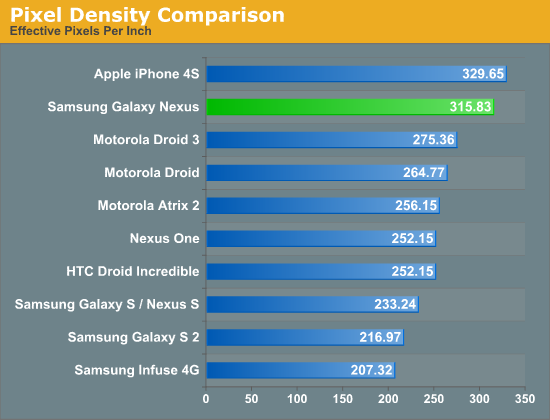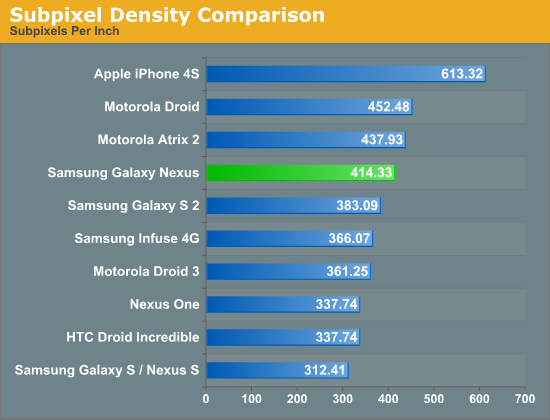Confirmed: Galaxy Nexus Includes PenTile
by Brian Klug & Jason Inofuentes on October 21, 2011 12:58 AM EST- Posted in
- Smartphones
- Samsung
- Ice Cream Sandwich
- Mobile
- AMOLED
- galaxy nexus
Though we've learned a lot about the Galaxy Nexus specifications already, one of the things that has remained a question thus far is whether its 4.65" 720p HD Super AMOLED display uses an RGB subpixel rendering layout or PenTile. We've now confirmed that the Galaxy Nexus display does in fact use RGBG PenTile, like all the Nexus devices to date. This isn't super surprising considering that Samsung has been pretty good about adhering to all the monikers it has gradually been tacking onto AMOLED. There are a number so far - 'super' connotes an optically bonded panel and digitizer stack, 'plus' connotes an RGB stripe, and now 'HD' connotes, well, 720p. HD Super AMOLED lacks Plus, and thus isn't an RGB stripe.
The next question is just what 4.65" HD Super AMOLED will look like, or whether the presence of PenTile will be as noticeable as previous AMOLED phones like the Nexus S / Galaxy S or Nexus One where it was arguably very noticeable. That said, at some subpixel density it should become difficult to impossible to notice PenTile's presence, it's just a matter of exceeding human visual acuity. Having not seen the Galaxy Nexus in person yet and given the absence of good macro shots of the display, we have put together a numerical comparison pitting the Galaxy Nexus panel up against some other common smartphone displays.
First up is a quick plot of the effective pixel density of some popular displays. Stated another way, this is the pixel density based on the manufacturer's stated logical resolution, which is also the resolution of Android's render target for the phone.

Note that this is the traditional means of reporting pixels per inch that we've published before. However, using this metric is just a bit misleading since it doesn't take into account the difference between 2 subpixel-per-pixel RGBG or RBGW PenTile versus the 3 subpixel-per-pixel RGB stripe. To make for an effective comparison, we've put together another plot where we take into account the presence of PenTile and report subpixel density.

Here things still look pretty good for the 4.65" HD Super AMOLED display, putting it just north of SGS2's Super AMOLED Plus display with an RGB stripe. I wager that if you were satisfied with the pixel density of SGS2 that the pixel density Galaxy Nexus actually won't be off-putting despite the presence of PenTile. In addition, hopefully some of the UI design considerations that come along with using PenTile (no vertical 1 pixel thick elements) have been taken into consideration from the outset for Ice Cream Sandwich. For true subjective impressions however, we'll have to wait and see.
Source: Data










152 Comments
View All Comments
deV14nt - Friday, October 21, 2011 - link
You're underestimating because of the word "inches." This device is 33% bigger in diagonal than the iPhone 4S. This is a bigger gap than the iPhone 4S being 25% bigger in diagonal than the HTC TouchPro, an old 2.8" Windows Mobile device. That device needed a stylus to poke the right button, and even then it was easy to miss all the buttons crammed into such a tight space. This is just as much a new generation of phones as the iPhone was compared to those old WinMo devices. Yet somehow, Apple got stuck there for 4 years. Glad to know we're still moving forward.zorxd - Monday, October 24, 2011 - link
Do you complain that your 46" TV has a lower pixel density than your 42" TV? I hope not.a5cent - Saturday, October 22, 2011 - link
It's not the screen size that is important, but the size of UI elements (especially text). Any one person will prefer a certain font size on their display irrespective of screen size. Given the same font size, an individual will hold devices with different screen sizes at the same distance where the device with the higher PPI will offer the higher quality rendering (ignoring Pen Tile displays for the moment).Also, you don't always want the highest resolution possible at a given screen size. At some point humans simply can no longer tell the difference. After that point choosing a device with a higher resolution for a given screen size (PPI) is simply sacrificing performance (pushing many more pixels around) and battery life for no perceivable benefit.
GuinnessKMF - Friday, October 21, 2011 - link
Umm... I care about PPI, it depends on what I'm using the device for. I actually prefer my laptop 17" 1920x1200 display over my desktop 24" 1920x1200 display, higher density at the same distance results in better looking images. For photo viewing density is key, for an immersive experience (gaming and movies) then screen size is key.There are absolutely uses for this kind of information and I am glad that they provide it, what exactly is the point of saying "why do we care", you may not care, but other people do, just don't read it, what do you gain by it not existing?
zorxd - Friday, October 21, 2011 - link
If someone offered you to exchange your 24" monitor for a 15" monitor of 1680x1050 (higher pixel density) would you accept?Of course not. Display size matters. And resolution too. Density doesn't, except as a consequence of the first two.
Skywalker_x86 - Friday, October 21, 2011 - link
From your argument: you would trade a 20" monitor with 1024x768 resolution for a 36" monitor with the same resolution, which would look much worse by comparison.The differences in screen sizes on these phones is minimal, so the density does matter. Pentile, at a certain density for "normal" phone use distance will look poorer at any of the current screen sizes. What this article is trying to point out, is that the pixel density may be high enough for the problems with using pentile to not be noticeable.
Please stop using monitors as an example, you're making terrible comparisons. 60% diagonal size loss on a monitor is much more extreme than the 16%, at most (4" to 4.65) on a phone.
Hopefully the nexus' screen is good enough to make the pentile matrix not give poorer quality images as it does in some of the older phones
zorxd - Tuesday, October 25, 2011 - link
Of course I prefer a 36" monitor over a 20" one with the same resolution. If only I could afford it. That's why I chose a 22" monitor over a 20" with the same 1680x1050 resolution. Even if it was more expensive and has a lower pixel density.Going from 3.5 to 4.65" is a 33% increase in diagonal, as someone else said. So it's pretty big.
a5cent - Friday, October 21, 2011 - link
Hi zorxd, I think you've got this completely backwards. PPI is the much better metric because it is a measurement of quality! A higher PPI values mean the display will render text and graphics clearer. Since we all see differently, each of us will set our own minimal PPI value at which we no longer realize the on screen image is composed of individual pixels. This minimal PPI value is what all of us should be paying attention to when shopping for a device. If I'm shopping for a smaller device with a 3.7" screen, will I be happy with a 800x480 resolution. I have no way of knowing without knowing what minimal PPI I am comfortable with. As you have already mentioned, screen size on it's own is basically worthless information.zorxd - Monday, October 24, 2011 - link
PPI isn't a measurement of quality.A 400 PPI screen is useless for a cell phone if it's under 2" or over ~6". Might be great as a watch or a tablet however.
Let's take the original Desire. It has a resolution of 800x480. Its successor, the Desire HD, has the same resolution. However, the screen size went from 3.7 to 4.3". Is it a downgrade? Of course not. Some people will prefer a smaller phone, other a larger.
But you can't argue that the smaller display is of better quality simply because of the PPI. What count is the resolution. Try to fit a web page on the 2" 400PPI display. It will look like crap because the resolution will be too low so you will have to scroll. However, a web page on a 1280x800 display looks just fine, no matter the size of the display, because web page are usually made for about that resolution.
Both Desires will fit the same number of lines of a given web page on their screen because both of them have the same resolution. It won't look better on the smaller display, only smaller.
A 960x540 4.3" display is of better quality than a 3.7" 800x480. Some people might accept the tradeof of getting a lower quality (lower resolution) display in order to get a more pocketable phone. There is nothing wrong with that. However, it would be stupid to argue that it would be an upgrade in quality.
Before Apple, nobody ever talked about PPI of displays. We never cared before, because what counts is the resolution. If Apple could increase their display size to 3.7" without making the phone bigger, it would be a very nice upgrade even if it would reduce the PPI. Unfortunately their marketing department won over the reason so they can't do that in any near future.
a5cent - Friday, October 21, 2011 - link
Sorry, that last sentence should read:As you have already mentioned, screen RESOLUTION on it's own is basically worthless information.